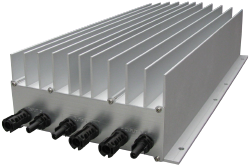
System voltages: 600–1500 V
Output currents: 32–50 A
Output powers: 15-70 kW
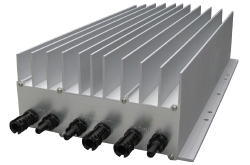
System voltages: 600–1500 V
Output currents: 20–32 A
Output powers: 11–45 kW
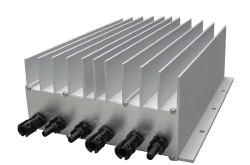
System voltages: 750–1500 V
Output currents: 16–20 A
Output powers: 9.3–28 kW
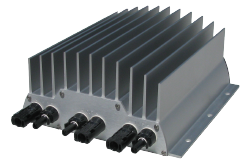
System voltages: 600–1000 V
Output currents: 12.0–13.5 A
Output powers: 5.9–12.2 kW
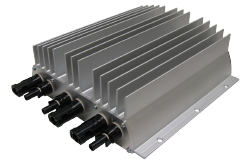
System voltage: 600 V
Output current: 12 A
Output powers: 4.8–6.8 kW
Ampt String Optimizers put maximum power point tracking on each of its two input strings of PV modules. This mitigates or eliminates mismatch losses to deliver more energy under changing environmental and system conditions over the lifetime of the power plant.
Ampt String Optimizers include V-match technology to automatically match the DC bus voltage while delivering full available power from the PV array. This increases system design flexibility, simplifies controls, and unlocks value across diverse applications.
Ampt’s HFVB technology enables the DC bus to operate at a constant voltage that is higher than variable voltage systems. The fixed voltage simplifies the connection and control of system components tied to the DC bus. The higher voltage delivers power at a lower current to reduce component and system costs.
Inverters in Ampt Mode operate in a fixed or narrow input voltage range that is closer to the maximum system voltage. This allows the inverter to deliver a higher AC output voltage at the same current which raises the inverter’s rated output power up to 50% to lower the inverter’s cost per watt.
Ampt’s patented String Stretch technology puts voltage and current limits on the output of each optimizer which doubles the number of modules per string and allows for smaller conductor sizing per kilowatt delivered to save up to 25% on electrical BOS costs.
For DC-coupled energy storage systems with battery converters, Ampt String Optimizers include Direct-to-Converter technology to operate the DC bus at a fixed voltage that is always higher than the battery voltage. This eliminates 50% of the battery converter’s power circuitry while increasing its power density to lower the converter’s cost per watt.
Ampt String Optimizers include Direct-to-Battery technology which allows them to connect directly to the battery and follow its state-of-charge voltage while delivering full power from the PV array. The optimizer, battery, and battery inverter share the same DC bus without using battery converters.
This Ampt feature allows PV system designers to achieve optimal DC:AC ratios; expand the DC power on existing systems without replacing inverters, combiners, or cables; optimize inverter utilization; and increase storage durations – all at a lower capex.
Ampt optimizers overcome string-voltage sizing constraints to fit more modules on a tracker than systems without Ampt. Increasing the number of modules per tracker allows system designers to fully use the tracker’s mechanical capacity and lower tracker cost per watt.
Ampt String Optimizers incorporate wireless communication to provide optional string-level data that is highly accurate, synchronous, and scalable to improve O&M, as well as enhanced controls for storage applications.
Contact us for more information
Learn more about the unique advantages that Ampt String Optimizers deliver for your PV project.